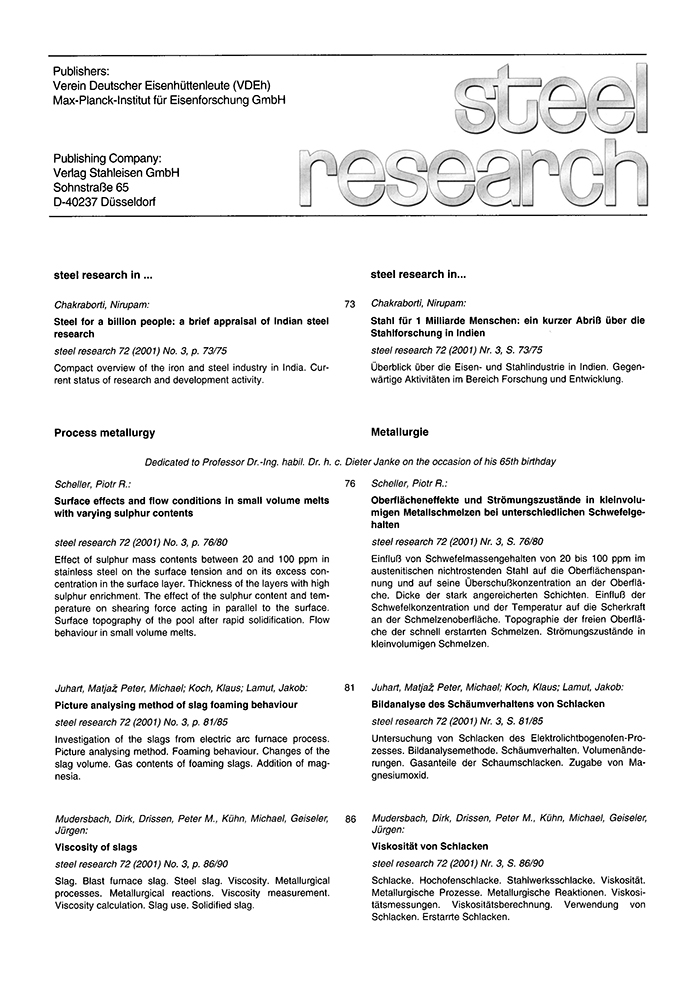Physical and mathematical modelling of flow and residence time distributions in different tundish designs
Abstract
enA steady state, three-dimensional, turbulent flow model has been developed in-house for analysis of melt flow and residence time distribution phenomena in steelmaking tundish system. The governing equations of flow, turbulence and tracer dispersion were derived in terms of the Cartesian co-ordinate systems and solved numerically with their associated boundary conditions adapting a control volume based finite difference procedure. In the numerical solution scheme, the pressure-velocity coupling was treated via the popular Simple (semi implicit method for pressure linked equations) algorithm.
Prior to carrying out elaborate numerical predictions for tundish geometry, the model was applied to several standard test problems and evaluated against corresponding bench mark results. Thus, several typical test problems such as, flows in a cubic cavity, flows in ducts of rectangular cross-section, flow over flat plate and so on were simulated numerically to assess the adequacy and appropriateness of the computational procedure developed. Results thus obtained together with the bench mark solutions indicated that the mathematical model is internally consistent and sufficiently robust. Accordingly, the turbulent flow model was applied to simulate flow and Residence Time Distributions (RTD) in four different tundish designs . These included, a single strand and a two strand slab casting tundish systems, a six strand rectangular shaped tundish and a six strand delta shaped billet casting tundish. Various RTD parameters (e.g., minimum break through time, tmin, time at which peak concentration occurs, tpeak and average residence time, tav) were computed numerically in the four tundish systems and these were subsequently compared with corresponding experimental measurements derived from equivalent water model tundish systems. Except for the single strand tundish system, large differences between measurements and prediction (particularly on tmin and tpeak) were noted for the other three tundish geometries. Furthermore, the extent of such discrepancy was found to be relatively more pronounced for the multi-strand tundish system. The possible reasons for such discrepancy is discussed in the text and it was shown computationally that relatively better agreement between theory and measurement can be achieved if, instead of the high Reynolds number k-ε turbulence model, a low Reynolds number turbulence model is applied in the computational procedure.
Abstract
dePhysikalische und mathematische Modellierung der Strömung und Verweilzeitverteilung für verschiedene Tundishbauarten.Ein stationäres, dreidimensionales, turbulentes Strömungsmodell wurde entwickelt. Es eignet sich zur Analyse der Schmelzenströmung und Verweilzeitverteilung im Tundish. Die Grundgleichungen für Strömung, Turbulenz und Verteilung der Legierungselemente wurden im Cartesischen Koordinatensystem hergeleitet. Ihre numerische Lösung erfolgte mit den entsprechenden Randbedingungen mit Hilfe einer finiten Differenzenprozedur. Im numerischen Lösungsschema läßt sich die Kopplung von Druck und Geschwindigkeit mit dem bekannten Simple-Algorithmus (semi implicit method for pressure linked equations) abhandeln.
Bevor die Tundishgeometrie numerisch vorausberechnet werden konnte, wurde das Modell zunächst mit einer Reihe von üblichen Versuchsproblemen getestet und mit den entsprechenden Bewertungsergebnissen weiterentwickelt. So wurden verschiedene charakteristische Versuchsprobleme - wie z.B. Strömung in kubischen Hohlräumen, in Kanälen mit rechteckigem Querschnitt, über flache Bleche etc. numerisch simuliert, um die Eignung der Rechenmethode zu überprüfen. Die daraus erhaltenen Ergebnisse zusammen mit den Lösungen aus dem Benchmarking weisen darauf hin, daß das mathematische Modell in sich konsistent und ausreichend robust ist. Dementsprechend wurde das turbulente Strömungsmodell auf die Simulation von Strömung und Verweilzeitverteilung (RTD) in vier verschiedenen Tundishbauarten angewendet. Darunter befanden sich auch ein- und zweisträngige Brammenstranggießsysteme, ein rechtwinkliger Tundish für eine 6-strängige Gießmaschine und ein Delta-Tundish für eine 6-strängige Knüppelgießanlage. Verschiedene RTD-Parameter (z.B. die minimale Durchbruchzeit, tmin, die Zeit, bei der Spitzenkonzentrationen auftreten, tpeak, und die durchschnittliche Verweilzeit tav) wurden für diese vier Tundishsysteme numerisch berechnet und anschließend mit vergleichbaren Messungen an äquivalenten Wassermodellen verglichen. Mit Ausnahme des einsträngigen Gießverteilers traten bei den drei anderen Bauarten große Unterschiede zwischen den Meß- und den berechneten Ergebnissen auf (besonders für tmin und tpeak). Darüber hinaus nahm die Abweichung mit der Anzahl der Stränge zu. Mögliche Gründe hierfür werden diskutiert. Berechnungen zeigen außerdem, daß eine bessere Übereinstimmung zwischen Rechnung und Experiment dann zu erreichen ist, wenn, anstelle des k-ε-Turbulenzmodells für große Reynoldszahlen, ein Turbulenzmodell für niedrige Reynoldszahlen für die Rechenprozedur herangezogen wird.




